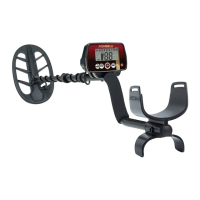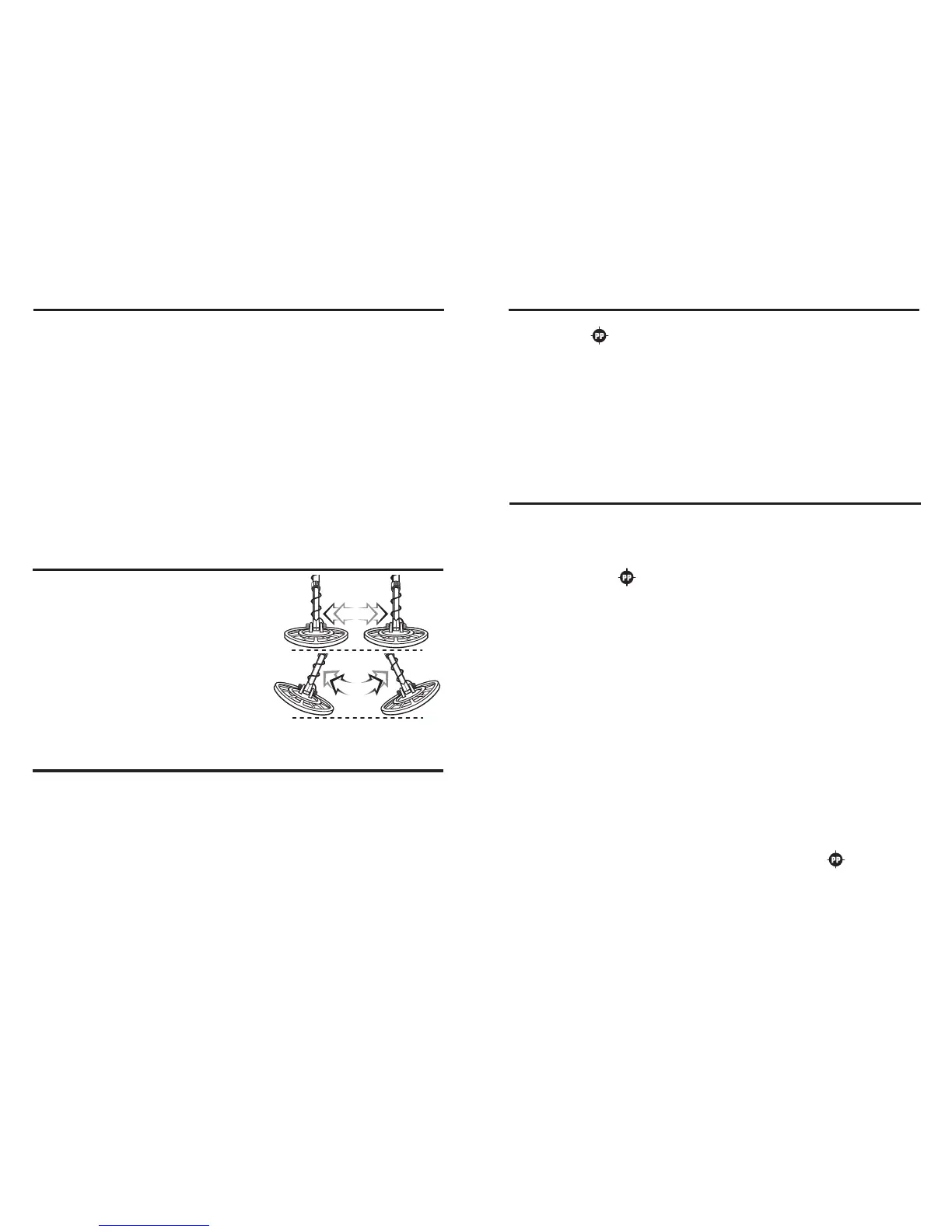10
15
HOW TO PINPOINT
After you have identified a target, move the coil to one side of the target, be
sure you are not over any metal, then press-and-hold the pinpoint button and
rescan the target.
Pinpoint as follows:
1. Press and hold
2. Position the searchcoil just barely off the ground and to the side of the
target.
3. Now move the searchcoil slowly across the target.
The target is located directly under where the sound is loudest and the depth
indication is smallest.
Narrow It Down:
1. For large targets you can narrow the response further by positioning the
center of the searchcoil near the center of the response pattern, but not
directly over the center.
2. Release Pinpoint.
3. Immediately press-and-hold again.
4. Repeat this narrowing procedure to narrow the field of detection further.
Note: Depth indication is less accurate after narrowing.
COIL DRIFT
If you plan to use PINPOINT for continuous searching, realize that drift will
occur over time, causing the detector to gain or lose sensitivity. Periodic
retuning of the detector is required to minimize drift; release and press
periodically to retune.
PINPOINTING USING MOTION MODES (without using )
1. Sweep over target in narrowing side-to-side patterns.
2. Visualize a “center line” on the ground where “beep” occurs.
3. Rotate 90° and now sweep along this imaginary line.
4. Visualize a second “center line” on the ground where “beep” occurs.
5. The “X” center pinpoints the target location.
PINPOINT
Press and hold to activate. Searchcoil motion is not required; a motionless
searchcoil over a metal target will induce sound. The screen will blank except for
the 2-digit number display indicating target depth in inches. The scale is calibrated
to coin-sized objects. The depth indication will vary as you scan your target. The
target center is where the smallest depth indication displays.
Tone and pitch of the audio will vary as the coil passes over the target. This
audio can yield more information about the target's shape and size and also
find its exact location to facilitate extraction. The target center is where the
loudest and highest pitch is indicated.
MENU
(Continued)
5. EMI (Electromagnetic Interference)
The searchcoil produces a magnetic field and then detects changes in that
magnetic field caused by the presence of metal objects. This magnetic field
the detector creates is also susceptible to the electromagnetic energy
produced by other electronic devices. Electric fences, cell phones, cell phone
towers, power lines, microwave ovens, lighting fixtures, TVs, computers,
motors, etc., all produce EMI which can interfere with the detector and cause
it to beep erratically.
The SENSITIVITY control lets you reduce the strength of this magnetic field
and therefore lessen its susceptibility to EMI. You may want to operate at
maximum strength, but the presence of EMI may make this impossible, so if
you experience erratic behavior or “false” signals, reduce the sensitivity.
THE BASICS OF METAL DETECTING
Sweep Method
Sweep the detector side-to-side over
the ground.
Keep the searchcoil parallel to the
ground as you sweep; do not lift the
searchcoil at the ends of your sweeps.
Searchcoil motion is required for target
detection.
USING THE DETECTOR
This detector is equipped with an 9” triangulated elliptical concentric
waterproof searchcoil. This lightweight, ruggedly constructed searchcoil
can be fully submerged into water. The bottom portion of the pole assembly
can also be submerged, but the control housing and the searchcoil cable
plug connection into the housing must not be submerged. The
weatherproofing on the F22 was designed to allow hunting in inclement
weather but it was not designed to withstand submersion in water.
Accessory searchcoils are also available for purchase; see back cover or
visit www.fisherlab.com. A smaller searchcoil offers more precision and fits
into tight spaces. Larger searchcoils provide for more ground coverage on
each sweep and penetrate deeper into the ground. Biaxial searchcoils
provide better penetration in mineralized soils.
9” WATERPROOF SEARCHCOIL

